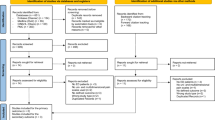Abstract
Background and aims
Acute pain is the most common reason for visits to the emergency department (ED). The underuse of analgesics occurs in a large proportion of ED patients. The physician’s accurate assessment of patients’ pain is a key element to improved pain management. The purpose of this study was to assess if physicians’ perception of pain can improve with looking at the pain score of the patient marked on VAS.
Study design
This was a single-center, cross-sectional prospective observational study, that took place in an academic ED.
Methods
All adult ED patients presenting with a painful condition were enrolled to the study. In the first phase of the study, the physician rated his/her opinion about the patient’s pain on a 100 mm VAS, in a blinded fashion to the patient’s pain score. In the second phase, the physician rated his/her opinion after looking at the pain scale marked by patient.
Results
587 patients (295, in first and 292, in second phase) were enrolled. The groups were not statistically different for demographic data. The physician’s perception of pain was lower than the patient’s pain score at both phases of the study. Insight of the patient’s pain score on VAS increased the physician’s pain perception significantly (p = 0.03). During the second phase, physicians ordered significantly more analgesic medications to the patients (p = 0.03).
Conclusion
The physicians’ perception of the patients’ pain differs significantly from the pain that the patient is experiencing. VAS helps to bring the physicians impression of pain perception to the level of pain that the patient is actually experiencing and resulted in ordering more analgesics to the patients. Implementation of a pain assessment tool can raise the physician’s perception of the pain and may improve pain management practices and patient satisfaction.


Similar content being viewed by others
References
Cordell WH, Keene KK, Giles BK, Jones JB, Jones JH, Brizendine EJ. The high prevalence of pain in emergency medical care. Am J Emerg Med. 2002;20:165–9.
Rupp T, Delaney KA. Inadequate Analgesia in emergency medicine. Ann Emerg Med. 2004;43:494–503.
Motov SM, Khan AN. Problems and barriers of pain management in the emergency department: are we ever going to get better?. J Pain Res. 2008;2:5–11.
Bartfield JM, Salluzzo RF, Raccio-Robak N, et al. Physician and patient factors influencing the treatment of low back pain. Pain. 1997;73:209–11.
Silka PA, Roth MM, Moreno G, et al. Pain scores improve analgesic administration patterns for trauma patients in the emergency department. Acad Emerg Med. 2004;11:264–70.
Nelson BP, Cohen D, Lander O, et al. Mandated pain scales improve frequency of ED analgesic administration. Am J Emerg Med. 2004;22:582–5.
Todd KH. Clinical significance of reported changes in pain severity. Ann Emerg Med. 1996;4:485–9.
Baumann BM, Holmes JH, Chansky ME, Levey H, Kulkarni M, Boudreaux ED. Pain assessments and the provision of analgesia: the effects of a templated chart. Acad Emerg Med. 2007;14:47–52.
Sucov A, Nathanson A, McCormick J, et al. Peer review and feedback can modify pain treatment patterns for emergency department patients with fractures. Am J Med Qual. 2005;20:138–43.
Zohar Z, Eitan A, Halpern P, et al. Pain relief in major trauma patients: an Israeli perspective. J Trauma. 2001;51:767–72.
Gallagher EJ, Bijur P, Latimer C, Silver W. Reliability and validity of a visual analog scale for acute abdominal pain in the ED Am. J Emerg Med. 2002;20:287–90.
Kelly AM. Does the clinically significant difference in visual analog scale pain score vary with gender, age, or cause of pain? Acad Emerg Med. 1998;11:1086–90.
Gallagher EJ, Libman M, Bijur P. Prospective validation of clinically important changes in pain severity measured on a visual analog scale. Ann Emerg Med. 2001;38:633–8.
Todd KH. Pain assessment and ethnicity. Ann Emerg Med. 1996;27:421–3.
Lasch KE. Culture, pain, and culturally sensitive pain care. Pain Manage Nurs. 2000;1(3 Suppl 1):16–22.
Todd KH, Deaton C, D’Adamo AP, Goe L. Ethnicity and analgesic practice. Ann Emerg Med. 2000;35(1):11 – 6.
Cintron A, Morrison RS. Pain and ethnicity in the United States: A systematic review. J Palliat Med. 2006;9(6):1454–73.
Bijur P, Bérard A, Esses D, Calderon Y, Gallagher EJ. Race, ethnicity, and management of pain from long-bone fractures: a prospective study of two academic urban emergency departments. Acad Emerg Med. 2008;15(7):589 – 97.
Bijur P, Bérard A, Nestor J, Calderon Y, Davitt M, Gallagher EJ. No racial or ethnic disparity in treatment of long-bone fractures. Am J Emerg Med 2008;26(3):270–4. https://doi.org/10.1016/j.ajem.2007.05.010.
Fuentes EF, Kohn MA, Neighbor ML. Lack of association between patient ethnicity or race and fracture analgesia. Acad Emerg Med. 2002;9(9):910–5.
Platts-Mills TF, Esserman DA, Brown DL, Bortsov AV, Sloane PD, McLean SA. Older US emergency department patients are less likely to receive pain medication than younger patients: results from a national survey. Ann Emerg Med. 2012;60(2):199–206.
Miner J, Biros MH, Trainor A, et al. Patient and physician perceptions as risk factors for oligoanalgesia: a prospective observational study of the relief of pain in the emergency department. Acad Emerg Med. 2006;13:140–6.
Singer AJ, Garra G, Chohan JK, Dalmedo C, Thode HC Jr. Triage pain scores and the desire for and use of analgesics. Ann Emerg Med. 2008;52:689–95.
Mogil JS, Sternberg WF, Marek P, et al. The genetics of pain and pain inhibition. Proc Natl Acad Sci USA. 1996;93:3048–55.
Mogil JS. The genetic mediation of individual differences in sensitivity to pain and its inhibition. Proc Natl Acad Sci USA. 1999;96:7744–51.
Fosnocht DE, Heaps ND, Swanson ER. Patient expectations for pain relief in the ED. Am J Emerg Med. 2004;22:286–8.
Author information
Authors and Affiliations
Corresponding author
Ethics declarations
Conflict of interest
All authors declare that they have no conflict of interest.
Funding
They have received no financial support for the research, authorship, and publication of this article.
Rights and permissions
About this article
Cite this article
Cakir, U., Cete, Y., Yigit, O. et al. Improvement in physician pain perception with using pain scales. Eur J Trauma Emerg Surg 44, 909–915 (2018). https://doi.org/10.1007/s00068-017-0882-7
Received:
Accepted:
Published:
Issue Date:
DOI: https://doi.org/10.1007/s00068-017-0882-7




